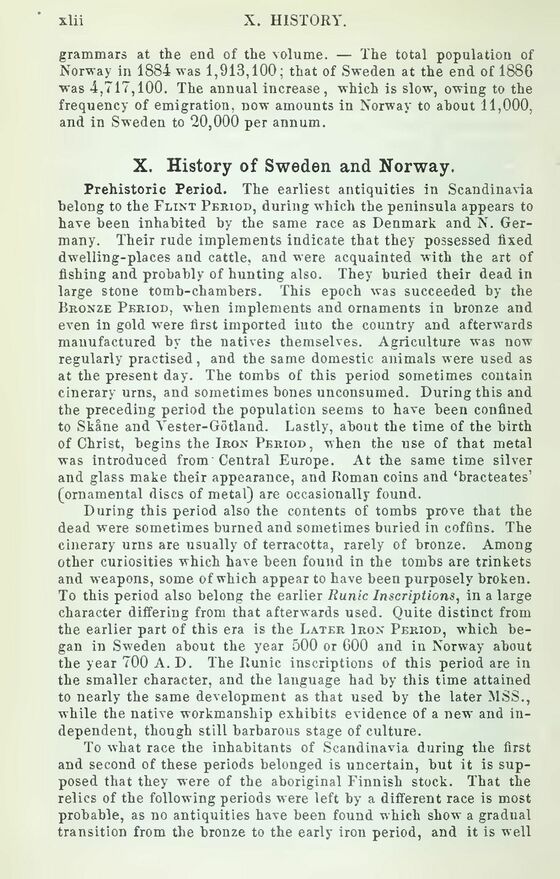
Full resolution (JPEG)
- On this page / på denna sida
- Introduction
- Pages ...

<< prev. page << föreg. sida << >> nästa sida >> next page >>
Below is the raw OCR text
from the above scanned image.
Do you see an error? Proofread the page now!
Här nedan syns maskintolkade texten från faksimilbilden ovan.
Ser du något fel? Korrekturläs sidan nu!
This page has been proofread at least once.
(diff)
(history)
Denna sida har korrekturlästs minst en gång.
(skillnad)
(historik)
grammars at the end of the volume. — The total population of
Norway in 1884 was 1,913,100; that of Sweden at the end of 1886
was 4,717,100. The annual increase, which is slow, owing to the
frequency of emigration, now amounts in Norway to about 11,000,
and in Sweden to 20,000 per annum.
X. History of Sweden and Norway.
Prehistoric Period. The earliest antiquities in Scandinavia
belong to the Flint Period, during which the peninsula appears to
have been inhabited by the same race as Denmark and N.
Germany. Their rude implements indicate that they possessed fixed
dwelling-places and cattle, and were acquainted with the art of
fishing and probably of hunting also. They buried their dead in
large stone tomb-chambers. This epoch was succeeded by the
Bronze Period, when implements and ornaments in bronze and
even in gold were first imported into the country and afterwards
manufactured by the natives themselves. Agriculture was now
regularly practised, and the same domestic animals were used as
at the present day. The tombs of this period sometimes contain
cinerary urns, and sometimes bones unconsumed. During this and
the preceding period the population seems to have been confined
to Skåne and Vester-Götland. Lastly, about the time of the birth
of Christ, begins the Iron Period, when the use of that metal
was introduced from’Central Europe. At the same time silver
and glass make their appearance, and Roman coins and ‘bracteates’
(ornamental discs of metal) are occasionally found.
During this period also the contents of tombs prove that the
dead were sometimes burned and sometimes buried in coffins. The
cinerary urns are usually of terracotta, rarely of bronze. Among
other curiosities which have been found in the tombs are trinkets
and weapons, some of which appear to have been purposely broken.
To this period also belong the earlier Runic Inscriptions, in a large
character differing from that afterwards used. Quite distinct from
the earlier part of this era is the Later Iron Period, which
began in Sweden about the year 500 or 600 and in Norway about
the year 700 A. D. The Runic inscriptions of this period are in
the smaller character, and the language had by this time attained
to nearly the same development as that used by the later MSS.,
while the native workmanship exhibits evidence of a new and
independent, though still barbarous stage of culture.
To what race the inhabitants of Scandinavia during the first
and second of these periods belonged is uncertain, but it is
supposed that they were of the aboriginal Finnish stock. That the
relics of the following periods were left by a different race is most
probable, as no antiquities have been found which show a gradual
transition from the bronze to the early iron period, and it is well
<< prev. page << föreg. sida << >> nästa sida >> next page >>
Project Runeberg, Sat Dec 9 14:19:04 2023
(aronsson)
(diff)
(history)
(download)
<< Previous
Next >>
https://runeberg.org/baenosw89/0050.html



